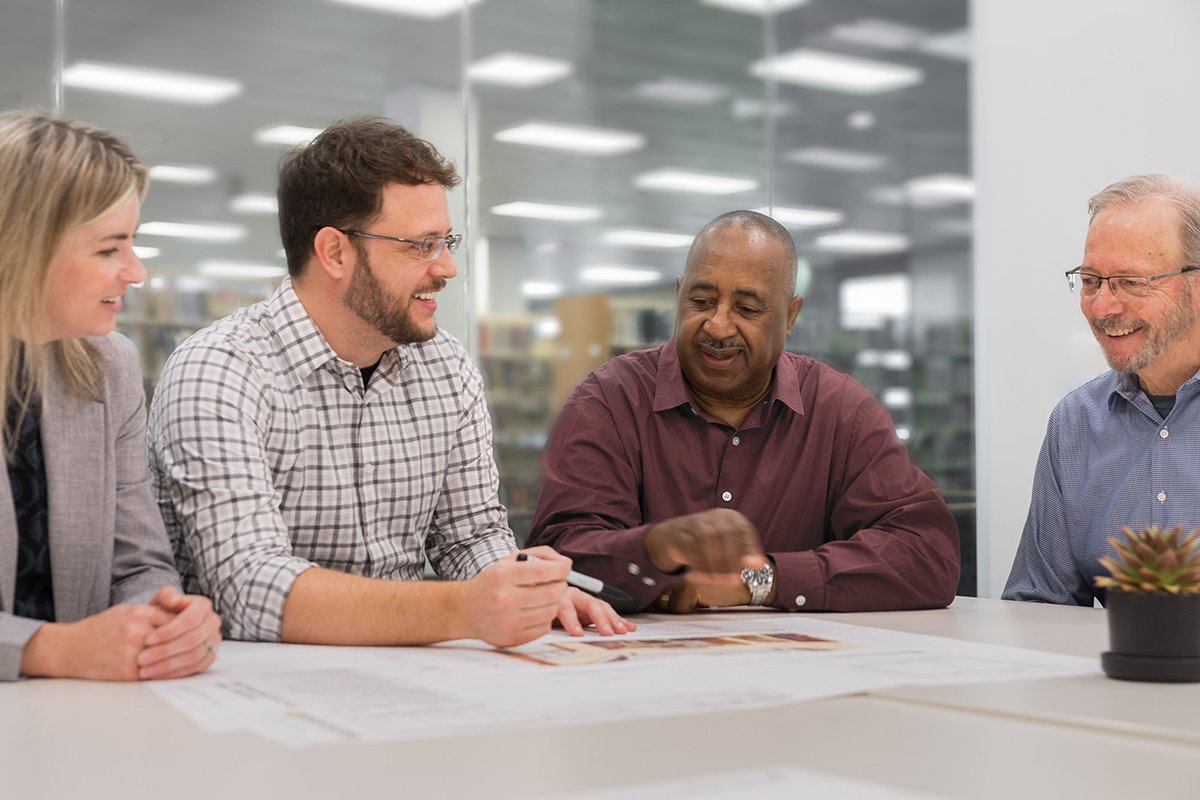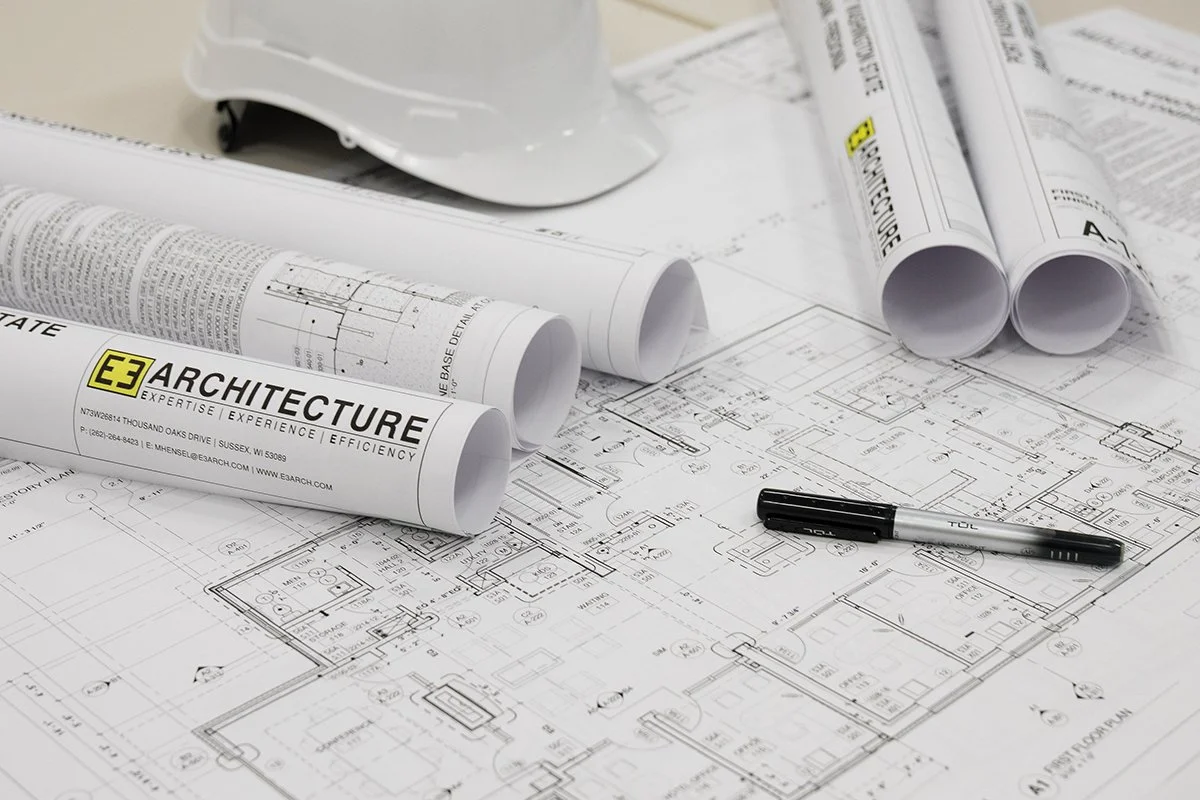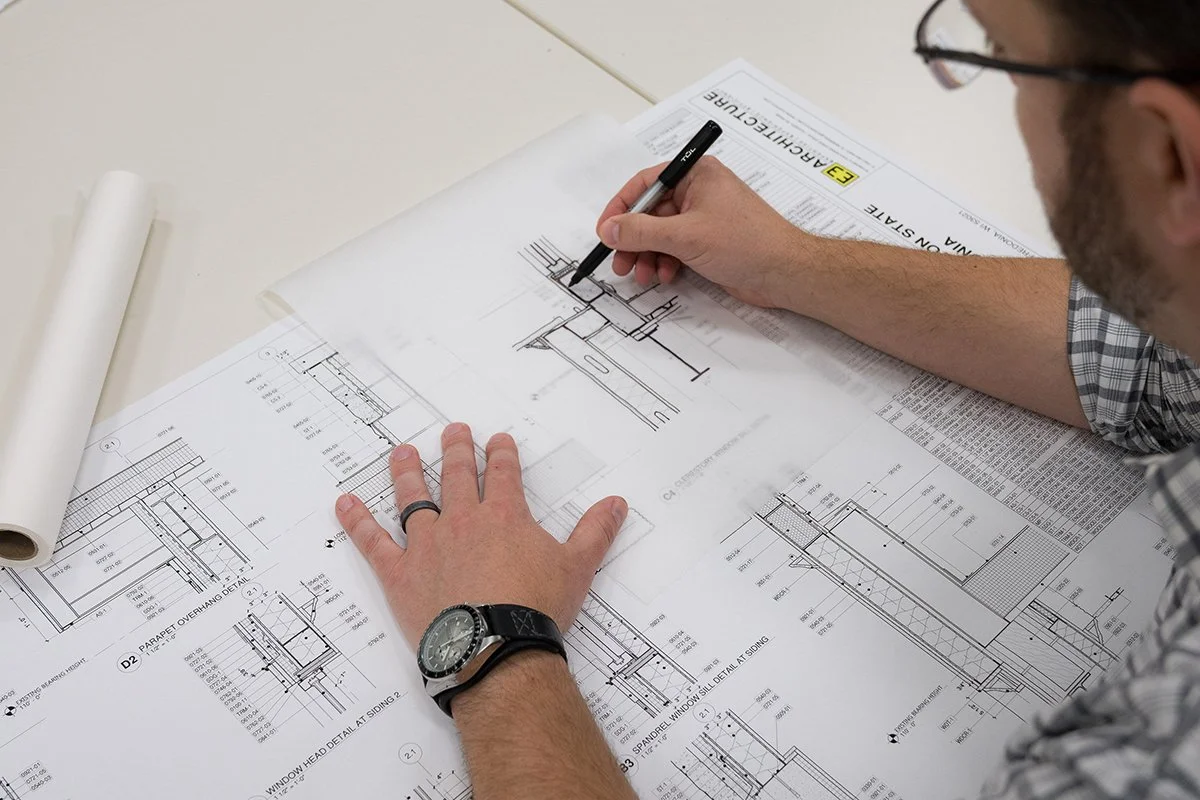SIMPLY PUT: A BLOG SERIES
SELECTING THE RIGHT COMMERCIAL ARCHITECT:
A STEP-BY-STEP GUIDE FOR BUSINESS OWNERS
June 13, 2025 | 8 minute read
By Matthew Hensel
By Matthew Hensel
Choosing an architect is one of the biggest decisions you will make for your project.
Making the right choice will greatly impact your results, and your experience. It can mean the difference between a frustrating hassle, and an enjoyable progression toward creating the exceptional workspace you and your team deserve.
Below is a step-by-step guide that walks you through the best practices when it comes to finding, vetting, and selecting the right architect for your commercial project.
STEP 1: PREPARE
1.1 Establish Your Objectives for the Project
Clear communication is the cornerstone of a successful project. Start your project off on the right path by collecting the information you will need to describe the requirements for your project in general terms. The information you collect at this time does not need to be highly detailed. Aim to have your main objectives clearly defined to help with the next few steps of the selection process.
Ask yourself questions about the following topics:
Project Requirements
What do you want to achieve with this project?
What existing issues need to be addressed to make this project successful?
Finances
How will the project be financed?
Does your project need to stick to a predetermined budget?
Schedule
Does your project need to be completed by a certain date?
Space Needs
Do you need more workspace for the employees you have now or for the ones you plan to hire in the future?
Does the workspace you have now empower your team to be as productive as possible?
Does your space accurately represent your company brand and culture?
When customers visit your space, does it make the right first impression? Can the customer experience be improved?
Optional Inclusions
Are there any “nice-to-haves” that you want to include but could exclude if necessary to stay within the project budget?
Design Style Preferences
Is there a particular design style that you prefer?
Pro Tip: Don’t worry if you are unsure how to establish your project budget. It can be difficult to set a budget when you are not familiar with how much construction projects typically cost. A good architect can help you to establish a realistic budget early in the process.
Pro Tip: Images are one of the most effective methods to communicate your stylistic preferences. Start to collect images of projects that align with your tastes.
1.2 Meet with Stakeholders
Next, consider meeting with your management team (or other stakeholders) to determine any additional needs. Discussing these topics with your stakeholders is a great way to gain more insights for your project.
STEP 2: RESEARCH
2.1 Find Candidates
Now it’s time to search for several qualified architects for you to consider. Aim to identify at least five candidates during this process so that you have enough options to compare in the following step.
It can be challenging to know where to look for commercial architects, so here are some helpful sources to find candidates for your project:
Previous Projects
Have you worked with an architect before? If so, was your experience positive? An architect that you have already worked with is certainly worth considering.
Have you worked with a general contractor before? Do you have a plumbing, electrical, or other type of contractor that you work with regularly? It’s highly likely that contractors that do commercial work have experience on projects that involved architects.
Recommendations
Ask around amongst your personal network of family and friends.
Referrals
Other business owners you know that have recently completed similar projects can be great referral sources. And if they had a bad experience, make note of who their architect was. Sometimes it just as valuable to know who not to work with.
LinkedIn - Reach out to your LinkedIn connections or create a post asking for referrals.
Internet Search
Google and other online search engines allow you to refine your search with relevant key words. Search for “commercial architects,” to avoid results showing architects that specialize in residential construction.
Local Directories
Your local Chamber of Commerce may have architects listed in their directory.
The American Institute of Architects (AIA) has local chapters all over the country and can provide referrals from their directory.
Pro Tip: Do you know anyone who works in the construction industry? They are more likely to have worked on projects with architects and can be a great resource.
Pro Tip: Include your location in your internet searches by adding in your state, county, or even city. Architects from your area are more likely to have valuable knowledge of local conditions and regulatory approval processes, making them more qualified for your project. Architects located far away will incur significant travel expenses when visiting your project, and these expenses will get passed on to you.
2.2 Screen Candidates
Now that you have identified a list of at least five candidates to consider, it’s time to narrow down the field. Focus on eliminating those who are least suited to your project's specific needs. Aim to have no more than three candidates remaining at the conclusion of this step in the process.
To filter out the least qualified candidates,
Review Candidate Websites
Make sure each candidate specializes in commercial architecture projects.
Has the firm built projects that are similar to yours in the past? Architects specialize just like doctors and lawyers. Make sure each candidate specializes in your type of project. Commercial design, renovations, etc.
Contact Candidates
Reach out to have a quick phone call with each candidate.
Consider asking questions about the following topics:
Schedule - Make sure each candidate has the availability to work on your project during your timeframe established in step 1.
License - Confirm that each candidate is licensed to practice in the state where your project will be built.
Insurance - Confirm each candidate carries professional liability insurance. Just like driving a car, practicing architecture comes with a certain amount of risk. Good drivers and good architects understand this and mitigate risk with insurance that protects themselves, and their clients.
Pro Tip: Skip the RFQ process. Large, complex projects (like hospitals or government buildings) use a formal process of request for qualifications (RFQ) to find suitable candidates. This method is too lengthy and time consuming for most small to medium-sized projects. The same information gathered through the RFQ process can be determined quicker and easier by researching and contacting candidates directly.
Pro Tip: For Wisconsin, you can quickly determine if a candidate is licensed to practice in the state. Follow this link and input the required information to get instant results.
STEP 3: INTERVIEW
3.1 Determine Selection Method + Criteria
Armed with your short-list of candidates, it’s now time to shift your focus to conducting more in-depth interviews. But before you begin interviewing candidates, it’s vital that you first make a few key decisions.
Ask yourself these questions about the following topics:
Selection Method
Who will be making the final decision on which candidate to work with?
Will the final decision be made by one person or a selection committee?
Selection Criteria
What criteria will be used to evaluate the candidates?
Common criteria include:
Qualifications
Relevant project expertise
Years of experience
Communication
Listening skills
Trustworthiness
Service
What’s included and excluded
Fees
Pro Tip: Keep the selection committee relatively small. Too many opinions can slow down and overcomplicate the process. And try to have an odd number of members. If the final decision comes down to a vote, you won’t end up with a tie.
Pro Tip: Don’t allow fees to be the primary selection criterion. Just as with anything else, with architects you get what you pay for. Architect fees usually constitute about 5-15% of the construction cost. And considering construction projects are often major investments, don’t jeopardize the success of your project to save a nominal amount of money on the architecture fee.
3.2 Determine Interview Questions
Using the selection criteria you have established, prepare a list of interview questions for the candidates. Ask each candidate the same set of questions to keep the information you have consistent.
Consider also including the following questions:
Qualifications
Do you have experience working on projects that are similar to mine?
Can you present case studies of these projects? Push for the candidates to present 1-2 in-depth case studies that are similar to your project. If you only ask for previous project examples you are likely to get a slideshow that includes a few pictures and statistics for each project, but that doesn’t really tell you much. Case studies will give you more insight into the creativity and problem-solving process behind the design.
How are you unique from other architects?
Who will be working on my project and what are their respective roles?
Communication
Who will be my main point of contact? Will this change throughout the course of the project?
What are the steps in your design process?
How will you present your design ideas?
How much of my input and time will be required and when?
Services
What services do you provide during design, bidding, and construction phases?
Which services are included, and which will cost extra?
“Look for a good listener, and you’ll find a good architect.”
- American Institute of Architects (AIA)
Pro Tip: Communication is key. You will need to make many important project decisions. The architect needs to communicate effectively to help you understand the options you have. If a candidate cannot effectively explain their design process to you in straightforward terms, it is likely more communication issues will arise throughout the project.
3.3 Interview Candidates
Now you’re ready to meet with the candidates and ask them your questions. Insist that all members of their proposed project team are in attendance. Otherwise, the people you will meet with will oftentimes not be the same people you will be working with. This is especially true with large firms that have dedicated sales staff.
And keep the conversation focused on the project team rather than the firm. Just because an architecture firm has been in business for many years, doesn’t mean the architect assigned to your project is experienced. Hearing about the firm experience is somewhat valuable, but focus on the project team members.
Here are some more best practices to use during the interview process:
Plan for at least 30 minutes for each interview. 60 minutes is ideal.
Meet in person, if possible. Online meetings are okay too, but try to avoid interviewing over the phone.
Request a written proposal that includes a detailed scope of services, and an estimate of the total architectural fees for the project.
Set aside some time after each interview to make some notes and reflect on your thoughts about the candidate.
Pro Tip: Conduct the interviews at your office or place of business. Seeing your space in person will help the architect understand your situation and provide better insight.
STEP 4: DECIDE
4.1 Compare Proposals
Architecture services vary widely so its important to understand what is included and excluded. Reviewing the proposals in detail with each candidate is the best way to see where the differences between candidates are. And remember, the cheapest option is rarely the best option. Instead of comparing fees, look for which candidate can provide the best overall value based on the selection criteria you established earlier on.
4.2 Notify Candidates
You’ve made your selection, now it’s time to share it. Start by notifying the candidate you have selected, letting them know they have been awarded the project, and discuss the next steps in the process. Then notify the other candidates, thank them for their time and effort, and address any follow up questions they may have about why they weren’t selected.
4.3 Execute an Agreement
Congratulations! You are just about ready to proceed with your project. The last step in the selection process is to execute an agreement with the architect. The architect will prepare an agreement detailing the scope of work, services and responsibilities of the architect and owner, budget requirements, project schedule, and architecture fees.
Review the contract carefully and ask questions as necessary to give youself a clear understanding of its terms and the roles and responsibilities of all parties.
RELATED POSTS
5 Costly Commercial Build Mistakes (And How Savvy Business Owners Avoid Them)
Avoid the top 5 commercial construction pitfalls that cost business owners time, money, and momentum. Learn how early planning, due diligence, and strategic partnerships can safeguard your investment and set your next workspace project up for success.
Productivity by Design: 5 Must-Know Tips for a High-Performing Workspace
Discover how E3 Architecture helps business owners design smarter workspaces that drive focus, reduce distractions, and elevate team performance—because productivity starts with the space you create.
Maximizing the Value from Your Architect: 5 Essential Tips for Business Owners
Boost your project's ROI with these 5 tips. Learn how active participation, early architect engagement, budget transparency, pre-design planning, and 3D visualizations can unlock your architect’s full value.




